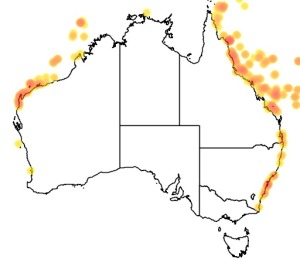�
�

©Anne Hoggett: A school of Naso unicornis at Dynamite Pass (Reef 14-140) near Lizard Island. Note short horn on forehead and trailing tail filaments.
�
���
Naso unicornis
Blue Spine Unicornfish

©Anne Hoggett: A school of Naso unicornis at Dynamite Pass (Reef 14-140) near Lizard Island. Note short horn on forehead and trailing tail filaments.
Kingdom
Animalia
Phylum
Chordata
Class
Actinopterygii
Order
Perciformes
Family
Acanthuridae
Genus
Naso
Species
Naso unicornis
Colours
Distinguishing features
A large olive grey fish with a short horn on the forehead, and a double pair of distinct blue spines at the tail base.
Size
- Up to 70 cm (Standard length)
Depth range
- Depth range data is not yet available.
Synonyms
Distribution
Distribution and habitat preferences
Areas of turf algae and coral rubble on reef flats and slopes, and lagoonal habitats.
Found in most reef locations around the island.
Behaviour
The Blue Spine Unicornfish is a roving herbivore, moving around the reef usually singly or in pairs, and feeding on large brown macroalgae. The surgeonfish are a very long lived group of fishes - after settlement to the reef, juveniles grow quickly and reach 80% of their maximum size in about 3 years, and then grow very slowly thereafter. Many of them live from 30-50years. They spawn in groups during the warmer months, when fast running tidal currents coincide with dawn and dusk.
Web resources
Danger
- unspecified - There are a pair of poisonous bony knives at the base of the tail, which can be used to inflict a painful stabbing wound if the fish is handled.
References
- Brandl, S.J. and D.R. Bellwood (2013). Morphology, sociality, and ecology: can morphology predict pairing behavior in coral reef fishes? Coral Reefs, 32: 835-836. LIRS catalog number 1718.
- Brandl, S.J. and D.R. Bellwood (2014). Individual-based analyses reveal limited functional overlap in a coral reef fish community, Journal of Animal Ecology, 83: 661-670. LIRS catalog number 2063.
- Brandl, S.J., W.D. Robbins and D.R. Bellwood (2015). Exploring the nature of ecological specialization in a coral reef fish community: morphology, diet and foraging microhabitat use, Proceedings of the Royal Society B, 282: 20151147, doi.org/10.1098/rspb.2015.1147. LIRS catalog number 1908.
- View all references



